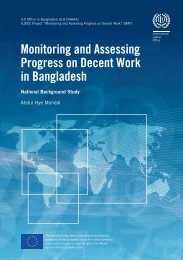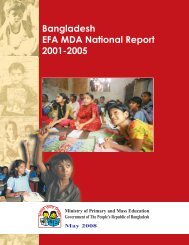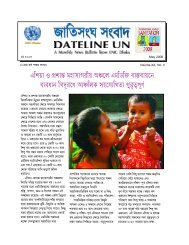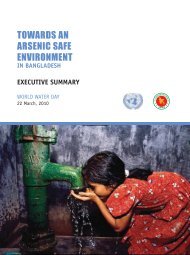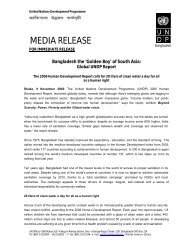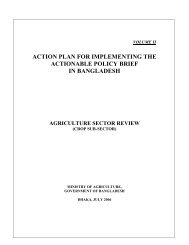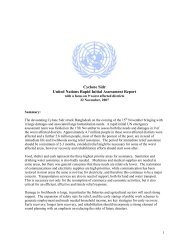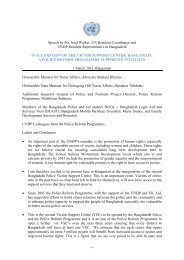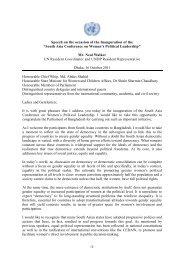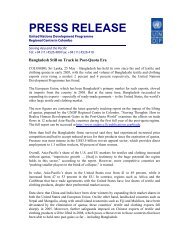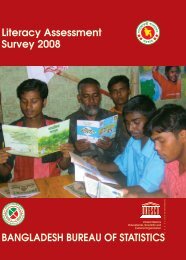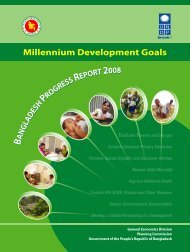MDG Report 2012 - United Nations in Bangladesh
MDG Report 2012 - United Nations in Bangladesh
MDG Report 2012 - United Nations in Bangladesh
- No tags were found...
You also want an ePaper? Increase the reach of your titles
YUMPU automatically turns print PDFs into web optimized ePapers that Google loves.
7.1 Introduction<strong>Bangladesh</strong> has performed quite well <strong>in</strong> halt<strong>in</strong>g communicable diseases under <strong>MDG</strong> 6. Theavailable data show that the prevalence of HIV/AIDS <strong>in</strong> <strong>Bangladesh</strong> currently is less than 0.1percent and thus is still below the epidemic level. There has been significant improvement <strong>in</strong>the reduction of malarial deaths <strong>in</strong> the country over the years. Moreover, a couple of<strong>in</strong>dicators related to TB have already met the <strong>MDG</strong> targets. It may also be mentioned thatsome of the <strong>in</strong>dicators are non-measurable <strong>in</strong> quantitative terms while, for several others, thebenchmarks are not available. In addition, several targets are def<strong>in</strong>ed <strong>in</strong> percentage termswhile others refer to absolute numbers.7.2 Progress of achievements <strong>in</strong> different targets and <strong>in</strong>dicatorsTarget 6.A: Have halted by 2015 and begun to reverse the spread of HIV/AIDSIndicator 6.1: HIV prevalence among population aged 15-24 yearsThe data of the 9 th round National HIV Serological Surveillance (SS) conducted <strong>in</strong> June 2011show that the prevalence of HIV/AIDS <strong>in</strong> <strong>Bangladesh</strong> is currently less than 0.1 percent andthus still below an epidemic level. However, <strong>in</strong> <strong>Bangladesh</strong>, behavioural factors among mostat risk populations (MARPs), explored <strong>in</strong> several rounds of Behavioural Surveillance Survey(BSS) show a trend that could fuel the spread of HIV from MARPs to the general population.The f<strong>in</strong>d<strong>in</strong>gs of the 9 th round National HIV SS are very encourag<strong>in</strong>g as these show that theoverall prevalence of HIV <strong>in</strong> populations most at risk rema<strong>in</strong>s below 1 percent and mostimportantly, HIV prevalence has decl<strong>in</strong>ed among people who <strong>in</strong>ject drugs <strong>in</strong> Dhaka from 7percent to 5.3 percent. Moreover, hepatitis C has also decl<strong>in</strong>ed which is a marker for unsafe<strong>in</strong>ject<strong>in</strong>g practices. Thus, the overall data suggest that the <strong>in</strong>tervention programmes arehav<strong>in</strong>g a positive effect. Still the most number of HIV positive people, irrespective ofpopulation groups, live <strong>in</strong> Dhaka despite the decl<strong>in</strong>e <strong>in</strong> the proportion of HIV positivesamong people who take drugs through <strong>in</strong>jection. The first case of HIV/AIDS <strong>in</strong> <strong>Bangladesh</strong>was detected <strong>in</strong> 1989. S<strong>in</strong>ce then 2,871 HIV positive cases have been identified; among them1,204 developed AIDS. Out of the total AIDS cases, 390 deaths have been recorded (as ofDecember <strong>2012</strong>).The specific issues emerg<strong>in</strong>g from the 9 th round of SS highlight that both HIV and HCV rateshave decl<strong>in</strong>ed <strong>in</strong> PWID <strong>in</strong> Dhaka suggest<strong>in</strong>g that ongo<strong>in</strong>g harm reduction programmes areeffective <strong>in</strong> prevent<strong>in</strong>g the spread of blood borne <strong>in</strong>fections <strong>in</strong> Dhaka. Other than PWID,another vulnerable population group appears to be the Hijra community as HIV was detected<strong>in</strong> the group from the locations where sampl<strong>in</strong>g was conducted. High rates of active syphilis(at >5%) was recorded <strong>in</strong> 10 cities amongst different population groups suggest<strong>in</strong>g thepractice of unprotected sex. Geographically, Dhaka appears to be the most vulnerable as thisis where the most numbers of HIV positive <strong>in</strong>dividuals were detected. Border areasparticularly Hili and Benapole are also vulnerable as HIV has been detected <strong>in</strong> these locationsamong different groups and cross border mobility <strong>in</strong> Hili is very high.73



